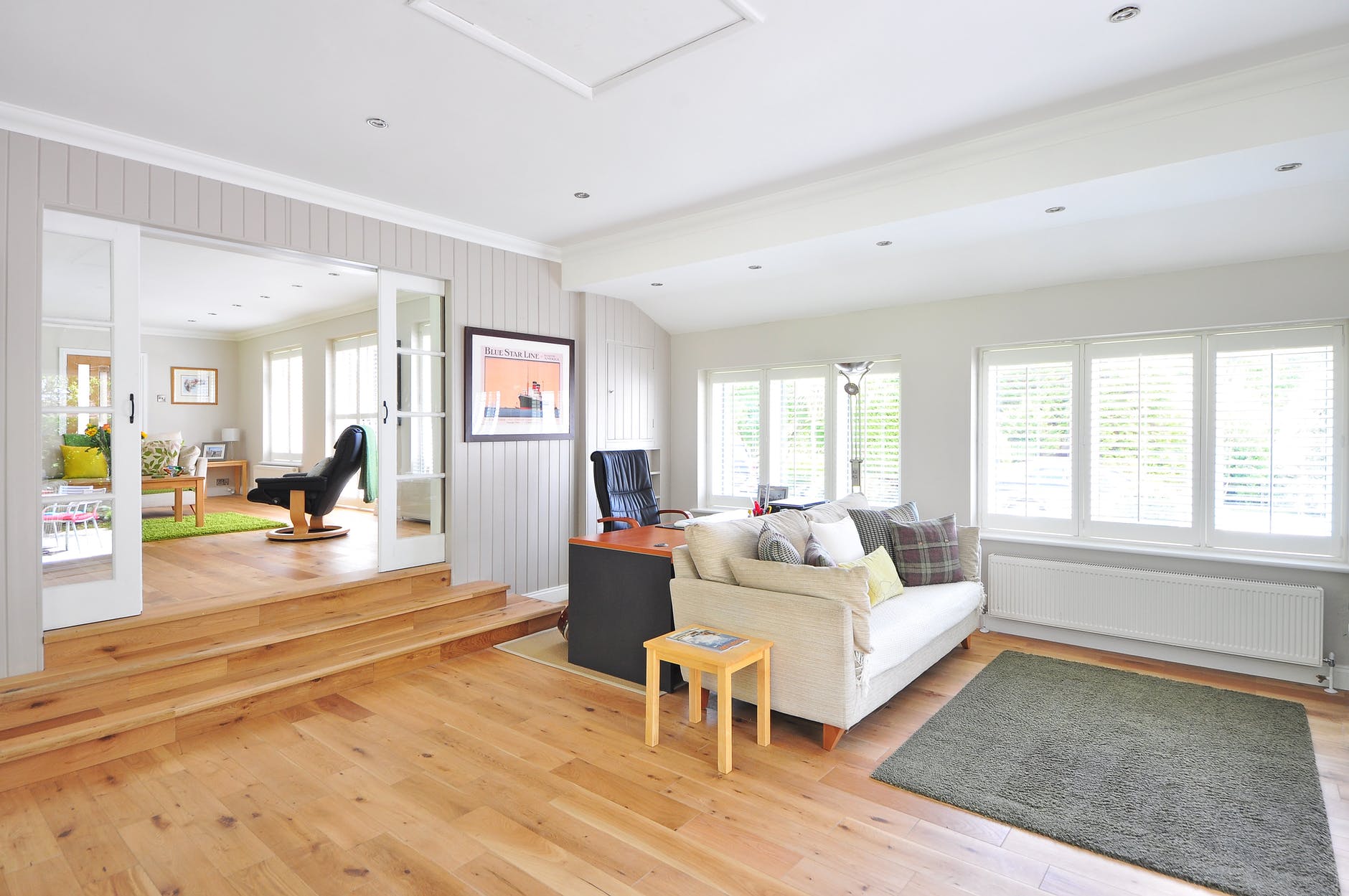Dirty Details
Formaldehyde
By fusing wood layers using glues and resins, composite wood flooring products such as engineered hardwood, bamboo, and laminate can be made. These glues often contain formaldehyde which is a known human carcinogen as well as a serious home air pollutant.
Formaldehyde-based adhesives are typically available in one of two types: either urea, phenol, or both. Urea-formaldehyde adhesives pose the greatest danger because they release formaldehyde over the entire life of the wood. Phenol-formaldehyde adhesives emit 90 percent less formaldehyde.
We recommend that you avoid all composite wood products due to the health risks associated with formaldehyde. There are several ways to reduce your exposure to the risks of composite wood flooring.
- Look for products that are labeled according to California’s Air Resources Board standards. These standards set voluntary standards for formaldehyde emissions resulting from composite wood products. These standards are the most stringent on the market regarding formaldehyde emissions and use. This is the best standard for indoor air quality. ULEF stands for ultra-low emission formaldehyde. It refers to products containing formaldehyde in their glues and resins, but emitting formaldehyde fumes that are extremely low levels as determined by the board.
- Products labeled NAUF (no added urea-formaldehyde) are the next best choices. The U.S. Green Building Council created this standard to indicate that the product does NOT use urea-formaldehyde. This releases formaldehyde over the product’s lifetime. NAUF products instead use phenol-based adhesives that emit 90% less formaldehyde.
- You can find the flooring that meets these standards, but you should look for flooring products that have been certified by the California Air Resources Board. These products will meet the basic safety standards for formaldehyde emission. These products will be labeled California Phase 2 Compliant. California Phase 2 standards are being mirrored by a new national standard for low formaldehyde emission in pressed wood products. This standard will be applied to products that are TSCA Title VI compliant. These products may be available as soon as 2018.
Sustainability
When choosing the floor, you should consider the impact of the product on your health. This is especially important when you use wood or bamboo products as poorly managed logging practices can have serious environmental impacts such as deforestation and loss of habitat, soil erosion, water pollution, and extinction of animal and plant species.
We recommend that you only purchase bamboo and wood products that have been certified by the FSC. This is the best indicator of sustainably harvested wood. You should be aware that not all FSC-certified products are available from every company. Make sure you read the labels on the bamboo or wood products you purchase.
Recommended Flooring
Solid surface flooring is preferred over carpet wherever possible. This will prevent you from the allergen and chemical air pollution that carpeting can cause.
Solid wood
Ideal for bedrooms and living spaces
Hardwoods such as oak and maple take longer to grow but they are generally more resilient to dents or damage than softwoods like pine, birch, and birch which can grow quickly and can be replenished more quickly. Although hardwood planks can be more expensive than raw material, the cost of installing and finishing the wood should not vary.
Verify that the wood species you select is not endangered. Friends of the Earth UK has a Good Wood Guide that provides more information about different types of timber.
Take note of the following when you use solid wood flooring:
- FSC-certified products are those that have been sustainably harvested. You can also check with green building retailers to find recycled or salvaged lumber that has not been glued, painted, or coated. Ask for documentation about the wood’s origin.
- To reduce carbon emissions, choose the wood that was harvested and processed locally.
- Wood flooring should be installed with nails and not glue
- Seal the floors with a water-based Green Seal 11-certified finish. Pre-finished floors can be used to prevent exposure to fumes and stains.
- Solid wood flooring can be damaged easily, making it unsuitable for use in bathrooms, kitchens, and laundry rooms.
Natural Linoleum
This product is suitable for all rooms, including bathrooms and kitchens.
Linoleum can be used as a flooring option that is both environmentally friendly and affordable. Linoleum is water-resistant and resilient. This makes it an excellent choice for bathrooms and kitchens.
Natural linoleum consists of a mix of linseed, pine resin, and wood flour. It also contains limestone, cork flour, limestone, and pigments that are pressed onto a jute backing. This low-maintenance option is suitable for concrete or wood subfloors. It usually requires a thin coat of natural wax (beeswax) and linseed oils to protect and care for. These floors can last decades if they are maintained properly.
When using linoleum flooring, be aware of the following:
- You can choose interlocking tiles of linoleum that are easy to install without adhesives or sheet linoleum using low-VOC and solvent-free adhesives.
- Linoleum is often used to refer to vinyl flooring. Make sure you choose natural linoleum that is made from linseed oils.
Dirt can cause scratches or stains to the wooden flooring Wirral. Regular vacuuming and damp mopping are important. Avoid soaking the flour in water and make sure to clean up any spillages immediately.
Porcelain, Ceramic and Glass Tile
This product is suitable for all rooms, including bathrooms and kitchens.
Glass tiles, porcelain, and ceramic are all good choices for solid-surface flooring. They are also great for areas that are subject to moisture like bathrooms and kitchens. Glass tiles made from recycled materials are a more sustainable option. Stone tile is not recommended as it can be energy-intensive to mine, transport, and handle.
Take note of these important points when you use tile flooring:
- To avoid the use of lead glaze, you can buy tiles made in the U.S.
- Use low-VOC cement backer board certified by Greenguard Gold or Low-VOC
- To set tiles, use water-based adhesive or cement thin-set (also called mortar).
- Use cement-based grout to avoid releasing harmful VOCs
- Protect grout and tiles with a low-VOC sealant
- To reduce dust inhalation, you can cut or grind tiles outdoors.

Use with Care
If you’re interested in bamboo, engineered hardwood, or cork flooring for your home, please follow our guidelines. These flooring products can only be recommended if they have been carefully selected using our criteria for avoiding harmful chemicals and products with negative environmental impacts.
Cork
This product is suitable for all rooms, including bathrooms and kitchens.
Because of its mold-resistant and moisture-resistant properties, cork flooring is often suitable for bathrooms and kitchens. Cork flooring is naturally fire-resistant, doesn’t absorb dust, warms underfoot, and provides cushioning when standing. Cork is a natural product that is made from bark from cork oak trees. Because harvesting does not cause damage to the tree, it can be easily recycled. Cork can be used over plywood, concrete, or any other flooring such as tiles or sheets. Cork can also be composted and recycled at the end of its useful life.
Cork floors may contain harmful binders and can have a variety of compositions.
When choosing cork flooring, ensure it is not a cork-vinyl-composite with a PVC backing, – Not made from crumb rubber, – Not made using formaldehyde binders, or carcinogenic Iocyanate; and – Recommended for areas of the home where it will most likely be used (e.g. bathrooms).
Engineered Hardwood
Ideal for bedrooms and living spaces
Engineered hardwood flooring is composed of a top layer made of real hardwood veneer and a core made of plywood or another wood material. Engineered hardwood flooring is easier to install than traditional hardwood. It can also be sanded or refinished up to once. However, glues and wood composite materials can contain formaldehyde.
When choosing engineered hardwood flooring, ensure that you carefully consider the following:
- FSC certified
- Formaldehyde-free glues
- Low-VOC finish or Green Seal 11-certified.
Bamboo
Bamboo is a fast-growing, renewable material that can easily be harvested every three to five years. Bamboo can live up to 50 years and some varieties are more durable than oak. However, some bamboo harvesting practices can be unsustainable and lead to deforestation. Currently, however, few bamboo products have been certified FSC.
Bamboo flooring is made up of glued strips. Until recently, all bamboo floors were made with formaldehyde-based adhesives. Isocyanates can also be found in some replacement glues. This can cause severe asthmatic symptoms such as respiratory irritation and sensitization.
After considering all other options, if you still love bamboo flooring, ensure that you carefully choose a product that meets these criteria.
- FSC certified
- Formaldehyde-free glues
- Low-VOC finish or Green Seal 11-certified.

Not recommended
Vinyl Flooring
Vinyl is a popular flooring option that’s easy to install and durable. Vinyl is made from petroleum-based chemicals and is therefore non-renewable. Vinyl is made of PVC (or polyvinyl chloride) plastic. This plastic produces toxic chemicals during manufacturing, such as dioxin, which can be a carcinogen or reproductive toxicant.
Vinyl flooring can contain multiple toxic chemicals, including phthalates. Phthalates can release toxins into building materials for many years after they have been installed. Phthalates can cause birth defects and disrupt hormones.
Be aware that vinyl floors older than 50 years old may contain asbestos. It is best to assume that asbestos is present when removing vinyl. To ensure compliance, a licensed contractor should be consulted. Asbestos is linked to mesothelioma and lung cancer.
Laminate Flooring
Laminate flooring is made from a “picture” of wood that has been glued to fiberboard. It cannot be sanded or refinished. Laminate flooring has come under fire for releasing significant amounts of formaldehyde. This is due to the glues that are used to join the laminate layers and the adhesives used during installation. Formaldehyde is a known human cancer gene. It has no safe exposure. This chemical has been linked with eye irritation, headaches, nausea, and other health problems.





